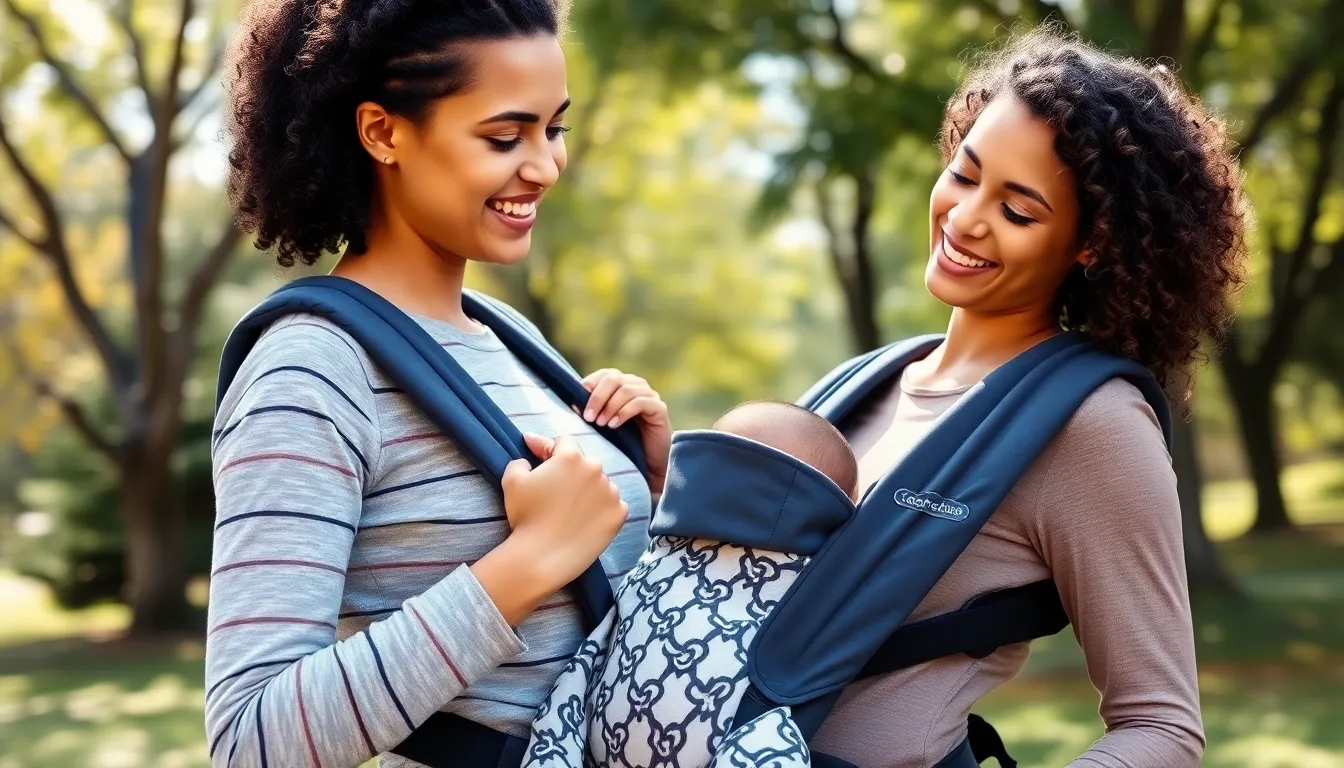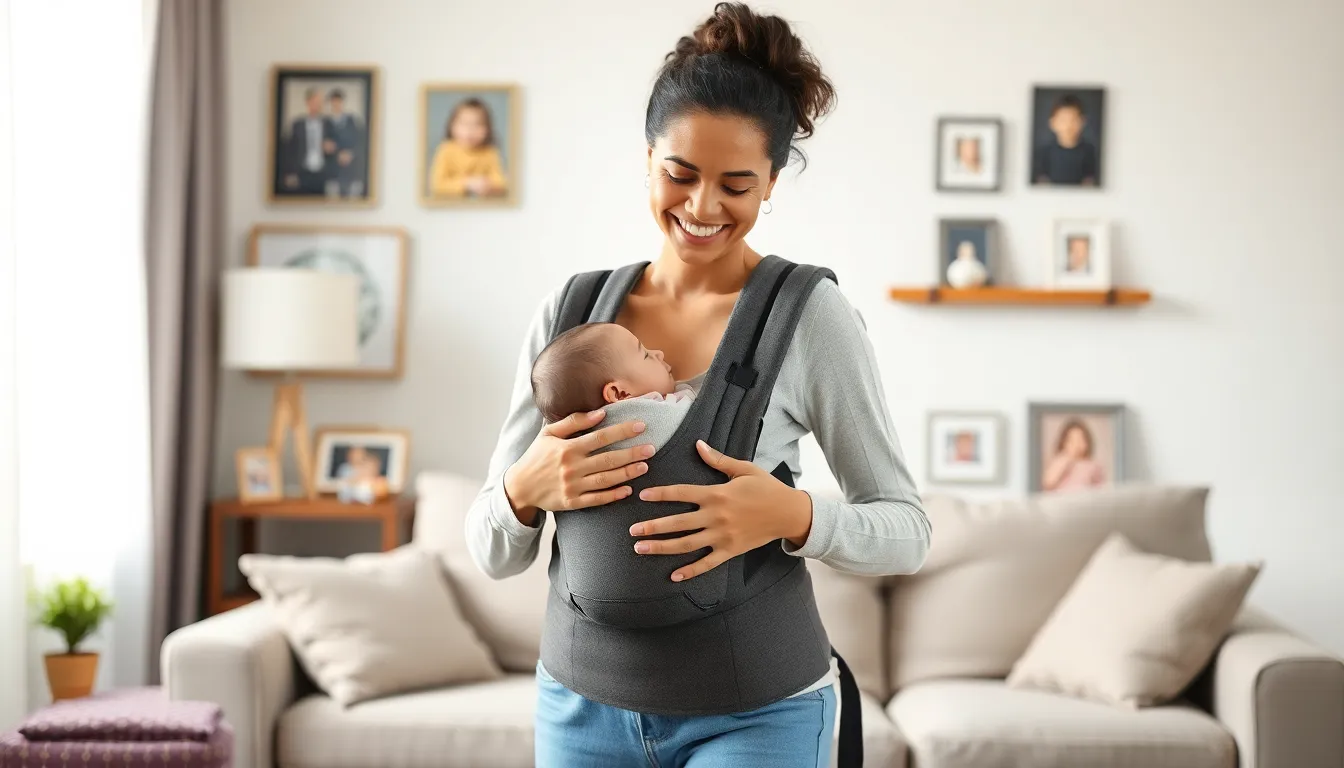When it comes to parenting, the quest for the perfect baby carrier can feel like searching for a unicorn. New parents often wonder if these trendy slings and wraps are safe for their precious newborns. After all, who wouldn’t want to keep their little bundle close while enjoying hands-free freedom?
But before strapping on that stylish carrier, it’s essential to dive into the world of baby safety. With so many options out there, it’s easy to get lost in the sea of fabrics and features. The good news? Understanding the safety guidelines can help parents confidently embrace the convenience of baby carriers without sacrificing their newborn’s well-being. So let’s unravel the mystery of baby carriers and discover if they’re the magical solution every parent dreams of—or just another fad that should stay in the past.
Table of Contents
ToggleOverview of Baby Carriers
Baby carriers come in various styles, including wraps, slings, and structured carriers. Each type offers unique benefits for parents and their newborns. Safety plays a crucial role in the selection process, especially for infants.
Infants require specific support for their necks and backs due to their developing muscles. Parents must choose carriers designed for newborns, with adjustable settings and proper ergonomic positions. Features like head support and a wide base enhance comfort for the baby.
Using a carrier promotes bonding through close contact, allowing parents to attend to chores while keeping their child close. Prolonged use of baby carriers may increase the risk of airway obstruction if infants are not positioned correctly.
In 2018, the American Academy of Pediatrics (AAP) released guidelines emphasizing the importance of monitoring the baby’s position in the carrier. Carriers must provide enough space for the baby’s legs and back to flex naturally.
Consideration of materials is essential as well. Breathable fabrics can prevent overheating, ensuring the baby remains comfortable during extended use. Some carriers incorporate safety features such as harnesses and buckles, providing extra security while carrying.
Other parents find it beneficial to consult with pediatricians or child safety experts before selecting a carrier. Knowledge about the specific needs of newborns will aid in making an informed decision about baby carriers. Ultimately, while baby carriers offer many advantages, safety should always be a priority.
Types of Baby Carriers

Different types of baby carriers cater to various needs, making it essential to choose one that ensures safety and comfort for newborns.
Soft Structured Carriers
Soft structured carriers offer a flexible design typically equipped with padded straps and an ergonomic seat. These carriers provide adjustable settings, allowing parents to achieve a snug fit for their newborns. Many features include head support, which is crucial for infants whose neck muscles are still developing. They distribute the baby’s weight evenly across the caregiver’s body, reducing strain on the back. Soft structured carriers are suitable for longer outings because of their supportive design. This kind of carrier typically provides a variety of carrying positions, accommodating the baby’s growth and changing needs.
Wraps and Slings
Wraps and slings present another option for parents seeking close contact with their newborns. Fabric wraps can be tied in various ways for a secure fit, while slings feature a simple loop design. Each option encourages skin-to-skin bonding, an essential aspect of early parenting. Wraps are versatile, allowing for multiple carrying styles and adjustments that cater to both parent and baby. Slings provide ease of use for quick trips, especially for caregivers needing hands-free options. Both choices emphasize gentle positioning, promoting a natural leg spread for infants and contributing to proper hip development.
Benefits of Using Baby Carriers
Baby carriers provide various significant benefits for both infants and parents, enhancing the overall experience of caregiving.
Enhanced Bonding
Using a baby carrier strengthens the emotional connection between parent and child. Close physical contact cultivates security and comfort for newborns. Feeling a parent’s warmth promotes healthy attachment, facilitating emotional development. Carriers also encourage skin-to-skin interaction, which further enhances bonding. Studies suggest that increased contact reduces crying and improves a baby’s overall mood. Parents feel more connected to their baby while engaging in daily activities. As the baby experiences the world, they gain reassurance from their parent’s presence. This interaction fosters a supportive environment for growth.
Convenience for Parents
Baby carriers offer practical solutions for busy parents. Hands-free mobility allows caregivers to manage daily tasks while keeping the baby close. Grocery shopping, cooking, and running errands become easier with a carrier. Transporting a baby without a stroller simplifies visits to crowded places. With various carrying positions available, parents can choose the most comfortable option. Versatile designs adapt to different situations, offering quick adjustments for optimal support. Lightweight materials make it convenient to use for extended periods. Most importantly, easy accessibility to the baby provides peace of mind.
Safety Considerations
Ensuring safety in baby carriers for newborns requires attention to specific guidelines and protocols. Emphasizing proper use enhances both safety and comfort for infants.
Proper Positioning
Correct positioning in a baby carrier is vital for preventing airway obstruction. Maintain a natural posture where the baby’s chin is off the chest, allowing for clear airflow. Check for adequate head and neck support, as newborns lack strength in these areas. Adjust the carrier to ensure the baby’s back is well supported and the legs are in a natural, spread-squat position. Following the manufacturer’s instructions aids in setting up the carrier properly. Regularly monitoring the infant’s position throughout use helps to ensure ongoing safety and comfort.
Age and Weight Limits
Each carrier has specific age and weight guidelines. Most structured carriers accommodate newborns who weigh at least 7 pounds, but some models may support lighter infants. Identify the weight limit stated by the manufacturer, as exceeding this limit can compromise safety. Newborns generally fit comfortably in carriers specifically designed for their age group, which often feature additional head support. Parents should consistently verify that their baby meets the age and weight requirements before using the carrier. Consulting product guidelines ensures each choice aligns with safety standards.
Recommendations from Experts
Experts recommend selecting carriers specifically designed for newborns, focusing on those that offer adjustable features and ergonomic support. Carriers should include head support to ensure the baby’s neck is adequately supported. Pediatricians emphasize monitoring the infant’s position regularly during use to prevent airway obstruction, advising parents to check that airflow remains unobstructed.
Permitting natural movement for the baby is crucial. Carriers must allow for a spread squat position, promoting proper hip development. The American Academy of Pediatrics advises parents to adhere to manufacturer guidelines regarding age and weight limits. Ignoring these limits can lead to safety issues, putting the baby at risk.
Favoring breathable materials is essential to prevent overheating. Fabrics with moisture-wicking properties enhance comfort and safety during use. Choosing a carrier that distributes weight evenly across the body helps minimize strain on the back and shoulders, particularly for longer outings.
Consulting child safety experts can provide further clarity on the safest carrying techniques. Incorporating feedback from experienced users can also help new parents make informed decisions. Carriers should facilitate skin-to-skin bonding, which is essential for the baby’s emotional development and foster security.
Ensuring that carriers comply with safety standards is a top priority. Regularly reviewing safety protocols can boost confidence in the product’s usage. Acknowledging that safety measures enhance the overall experience for both parents and infants underscores the importance of making informed choices. Each action taken to prioritize safety contributes to a more positive carrying experience.
Baby carriers can be a valuable tool for new parents when used correctly. They provide a unique opportunity for bonding while allowing hands-free convenience. However safety should always come first. Choosing the right carrier designed for newborns and adhering to safety guidelines is essential. Parents must ensure proper positioning and monitor their baby’s comfort to prevent any risks.
By prioritizing safety features and consulting experts when needed, parents can enjoy the benefits of baby carriers with peace of mind. With the right approach, baby carriers can enhance the parenting experience while keeping newborns safe and secure.



